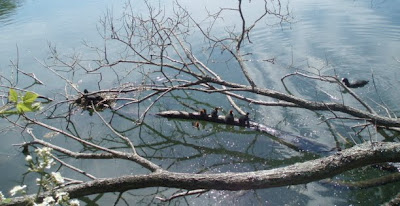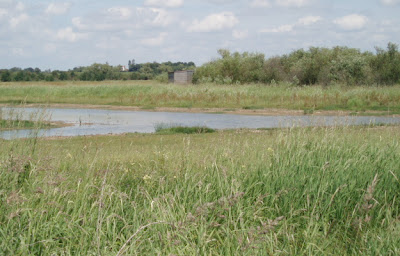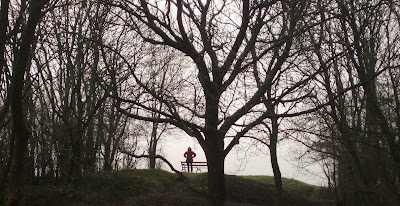Thames and the Countryside
I've just finished reading " Rural England: The battle against the bland" Paul Kingsnorth: Pub.2008.
In this book he makes some alarming future assertions, with regard to the English Countryside.
Here are two excerpts:
" A report published in 2003, called 'The State of the Countryside 2020' assumed the business ethos of the city was applicable to the countryside. It assumed people are prepared to accept a countryside, in which the barns are empty of cows, but full of 'choice managers.'
Above all, they assume one huge and untrue thing: that, in essence, the countryside is the same as the town; being a green business park, with the same pace of life, experiential framework, mortality and ethos as the town..
It is the city with more trees, less pollution and a lot more free parking, and anyone sufficiently sentimental to imagine otherwise is just not being competitive enough " P139- 140.
and further:
" if we are the global chosen, we will be given access to this season's look and access to credit to buy it. At weekends, we will be given time off, which we may perhaps choose to spend visiting one of the theme-park manifestations of our landscape which has replaced the real thing and which, for a small entrance fee we can enjoy with the benefit of a guided audio tour and a latte-to-go." P267.
I think you will agree this is a very dismal view indeed. The trouble is, dear readers, some of this scenario is happening right now. Having walked, as you know The Cotswold Way; I saw the following disquieting features.
1 A general absence of livestock; with the consequence of few working farms.
2 Few farm workers due to 1 above; but also due to mechanical sophistication, which meant less 'man-power'
3 Closure of village pubs, because of rising costs imposed and more generally because of lack of regular daily customers. No local workers.
4 Villages chock full of of barn-type conversions and expensive housing; sometimes of the second house variety. This, of course raises the price, causing the local villagers to be unable to buy and in so doing making those Cotswold villages into a day-time dormitory existence.
What is the answer ?
Well fortunately Paul Kingsnorth has some suggestions and working examples:
http://www.onceuponatree.co.uk/about-us/dragon-orchard.html
Using the link above, you will be taken to the innovative Dragon Orchard website.
Dragon Orchard, is situated near Ledbury and invites the public to share or sponsor in the orchard.
The benefits allow visits on a seasons basis and thus promotes a customer base and direct sales to be made.
In addition there is a farm shop for the general public.
This process draws public and producer together in a virtuous circle; which in turn allows the producer
to stay and expand ( if he/she wishes) in the locality.
In a further example, the author shows how a village collective took over and ran the village shop; expanded the goods and wielded together a community spirit, bringing another virtuous circle to fruition.
Finally he makes a very convincing argument for an English Parliament; by which we can bring our desires to build affordable housing and begin to reclaim the countryside before it slips away like used Morris Dancer's bells.
http://www.thecep.org.uk/wordpress/
Right, sorry about all that, having got that off my chest, let's get back to the Thames Path.
This is a very exclusive private estate in the middle of a nature reserve.
I have published a link on Twitter ( @curlykale), which explains this remarkable estate.
Suffice to say; the irony should not be lost that these properties are as exclusive as any to be found along the entire length of the Thames; yet only two to three miles from the Source.
After the "Prisoner" like quality of Lower Mill, all coded gate entry and CCTV, it was a relief to follow the path into woodland.
Finally here is a scene from Ashton Keynes, my destination and looking like a mini-Thames scene.
A good place to end.
Ciao4now
Ck.
In this book he makes some alarming future assertions, with regard to the English Countryside.
Here are two excerpts:
" A report published in 2003, called 'The State of the Countryside 2020' assumed the business ethos of the city was applicable to the countryside. It assumed people are prepared to accept a countryside, in which the barns are empty of cows, but full of 'choice managers.'
Above all, they assume one huge and untrue thing: that, in essence, the countryside is the same as the town; being a green business park, with the same pace of life, experiential framework, mortality and ethos as the town..
It is the city with more trees, less pollution and a lot more free parking, and anyone sufficiently sentimental to imagine otherwise is just not being competitive enough " P139- 140.
and further:
" if we are the global chosen, we will be given access to this season's look and access to credit to buy it. At weekends, we will be given time off, which we may perhaps choose to spend visiting one of the theme-park manifestations of our landscape which has replaced the real thing and which, for a small entrance fee we can enjoy with the benefit of a guided audio tour and a latte-to-go." P267.
I think you will agree this is a very dismal view indeed. The trouble is, dear readers, some of this scenario is happening right now. Having walked, as you know The Cotswold Way; I saw the following disquieting features.
1 A general absence of livestock; with the consequence of few working farms.
2 Few farm workers due to 1 above; but also due to mechanical sophistication, which meant less 'man-power'
3 Closure of village pubs, because of rising costs imposed and more generally because of lack of regular daily customers. No local workers.
4 Villages chock full of of barn-type conversions and expensive housing; sometimes of the second house variety. This, of course raises the price, causing the local villagers to be unable to buy and in so doing making those Cotswold villages into a day-time dormitory existence.
What is the answer ?
Well fortunately Paul Kingsnorth has some suggestions and working examples:
http://www.onceuponatree.co.uk/about-us/dragon-orchard.html
Using the link above, you will be taken to the innovative Dragon Orchard website.
Dragon Orchard, is situated near Ledbury and invites the public to share or sponsor in the orchard.
The benefits allow visits on a seasons basis and thus promotes a customer base and direct sales to be made.
In addition there is a farm shop for the general public.
This process draws public and producer together in a virtuous circle; which in turn allows the producer
to stay and expand ( if he/she wishes) in the locality.
In a further example, the author shows how a village collective took over and ran the village shop; expanded the goods and wielded together a community spirit, bringing another virtuous circle to fruition.
Finally he makes a very convincing argument for an English Parliament; by which we can bring our desires to build affordable housing and begin to reclaim the countryside before it slips away like used Morris Dancer's bells.
http://www.thecep.org.uk/wordpress/
Right, sorry about all that, having got that off my chest, let's get back to the Thames Path.
This picture of ducks and chicks was taken of the still-watered Neigh Bridge water park.
From there the trail led by road and path until Lower Mill Estate was reached.
This is a very exclusive private estate in the middle of a nature reserve.
I have published a link on Twitter ( @curlykale), which explains this remarkable estate.
Suffice to say; the irony should not be lost that these properties are as exclusive as any to be found along the entire length of the Thames; yet only two to three miles from the Source.
After the "Prisoner" like quality of Lower Mill, all coded gate entry and CCTV, it was a relief to follow the path into woodland.
Here is an example of the sun-dappled Thames beginning to establish itself alongside the path.
A good place to end.
Ciao4now
Ck.







Comments
Post a Comment
please feel free to comment and point out faults.
glad to have you aboard .
Curlykale.